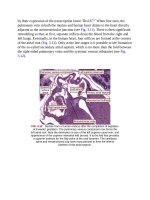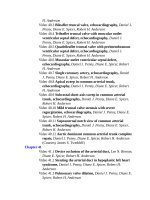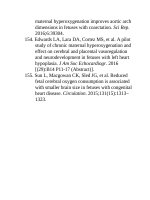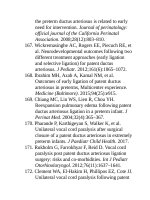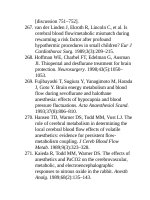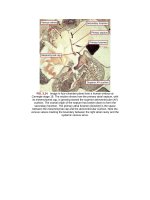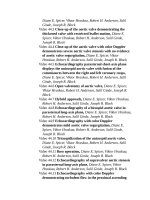Andersons pediatric cardiology 1110
Bạn đang xem bản rút gọn của tài liệu. Xem và tải ngay bản đầy đủ của tài liệu tại đây (194.06 KB, 3 trang )
aspect(comparewithFig.42.5).Right,Arrangementoftheopenedvalve.
Thefusionoftheleafletscreatesamorecircularattachmentwithintheroot,
producingtheannularparadox.
Thisfeature,inwhichring-likeattachmentsoftheleafletsbecomeevident
onlywhenthevalveismalformed,canbeconsideredtorepresentanannular
paradox.Thus,althoughtheorificeofthenormalpulmonaryvalveisoften
describedintermsofthe“annulus,”themeasurementtakenatthislevelbythe
echocardiographerisavirtualdiameteratthelevelofthebasalring(Fig.42.7).
FIG.42.7 Sectionacrossthepulmonaryroot.Themeasurementusually
takenbytheechocardiographerasthe“annulus”(redline)isatthelevelof
thebasalattachmentoftheleaflets.Thisisavirtualring,havingno
anatomiccounterpart.Thetrueanatomicringsintheroot,thesinutubular
andanatomicventriculoarterialjunctions―shownbythegreenandblue
lines,respectively―arerarelymeasuredbytheechocardiographer.
Insomeinstancesitispossibletoidentifyfourraphes,suggestingthatthe
valveitselfinitiallyhadfourleaflets.3Commissuralfusioncanalsoproduce
pulmonarystenosisinthesettingofabifoliatevalve(Fig.42.8A),whereasin
otherinstancesthepulmonaryvalvecanbenotonlybifoliatebutalsobisinuate
(seeFig.42.8B).
FIG.42.8 Bifoliatepulmonaryvalves.(A)Trisinuatevalvewithaconjoined
leaflet.(B)Incontrast,avalvewithonlytwosinusessupportingthetwo
leaflets.
Nonetheless,thetypicallesionproducingpulmonaryvalvarstenosisis
uniformfusionoftheperipheralzonesofappositionofatrifoliatevalve,leaving
acentralaperture.Usuallythisarrangementisassociatedwithsomedegreeof
thickeningattheunionofthezonesofappositionwiththesinutubularjunction.
Thisisdescribedsurgicallyastethering(seeFig.42.4).Accentuationofsuch
tetheringcanproducemarkednarrowingatthesinutubularjunction,often
describedasbeingsupravalvar.Inrealitythesinutubularjunctionisanintegral
partofthevalvarcomplex.Insomeinstancesvalvarstenosisistheconsequence
ofdysplasiaoftheleaflets,makingthemthickandmucoid.Suchthickeningis
sufficienttoproduceobstructionofthevalvarorifice,evenwhentheleaflets
themselvesarenotfusedalongtheirzonesofapposition(Fig.42.9A).Mostof
thepatientswithUllrich-Noonansyndromehavethistypeofstenosis.4Dysplasia
canalsobefoundwheneitherthetrifiliateorbifoliatevalveisalreadyitself
stenotic,thusexacerbatingtheextentofthenarrowingatthevalvarorifice(see
Fig.42.9B).
FIG.42.9 Consequencesofvalvardysplasia.(A)Withthepulmonary
trunkamputatedatthelevelofthesinutubularjunction,thestenotic
pulmonaryvalveisviewedfromthearterialaspect.Dysplasiaofthethree
valveleafletsisseentobenarrowingthevalvarorifice.Thestarsshowthe
so-calledvalvarcommissures.(B)Thevalveisitselfbifoliatewitha
conjoinedleaflet,andtheorificeextendstothesinutubularjunctionatonly
twosites,asshownbythestars.Inthisvalve,thedysplasticleaflets
excacerbatethenarrowingbecauseofthebifoliatenatureofthevalve.
Notetheannularnatureofthehingesofthetwoleaflets.
Althoughpulmonaryvalvarstenosismaybeconsideredasimplelesion,itis
rareforthelesiontobetotallyisolated.Thereisalmostalwayshypertrophyof
therightventricularwalls.Intheneonatewithcriticalvalvarstenosis,such
hypertrophymaybesevere,withaccompanyingfibrosisoftheendocardiumand
thickeningofthetensionapparatusofthetricuspidvalve.Therightventricle
thenresemblesthesituationseenatthefunctionallybiventricularendofthe
spectrumofpulmonaryatresiawithintactseptum(seeChapter43).Thefindings
ofareasofsubendocardialrightventricularinfarctionintheabsenceofcoronary
arterydisease,coupledwithextensiveareasofdisarrayinthemyocardialand
arterialwalls,pointtothediseasebeingmoregeneralizedthanwouldbe
expectedfromasimplevalvarlesionproducingdirecthemodynamiceffects.5In
agoodproportionofcaseswithpulmonaryvalvarstenosisofwhatevertype,
thereisanassociateddeficiencyoftheatrialseptum.Indaysgoneby,so-called
cardiaccirrhosiswasnotedinadultsdyingwithpulmonarystenosis,6butsuch
hepaticchangesareunlikelytobeencounterednow.
